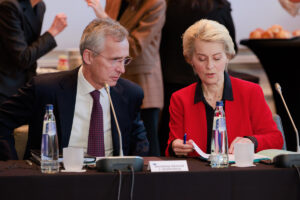 Despite the vehement reactions of the authorities from Bucharest against the multi-speed Europe, the reality on the ground (literally, on the ground) shows that we remained a country completely disconnected from the European Union.
Despite the vehement reactions of the authorities from Bucharest against the multi-speed Europe, the reality on the ground (literally, on the ground) shows that we remained a country completely disconnected from the European Union.
The maps that we present today (made by Vasile Iuga, PwC Senior Adviser) take the problem regarding all sorts of infrastructure out of the clichés domain:
The road infrastructure, as well as the gas infrastructure, from North to South and from East to West, bypass us.
The hub of the East to Europe is Hungary – which, unavoidable, seems to live from it.
Implementing the actual connection to Europe could still take some decades, given the status in 2017. Of course, if Europe stands by to wait for us.
But better let the maps talk:
Transportation infrastructure: North, South and East bypass us to join together in Europe. In fact, in Hungary
„In a European Union that has little money and even less generously, it will be increasingly difficult to catch up,” wrote in an analysis from 2016 Vasile Iuga, PwC Senior Adviser.
„The urgency of the internal and external reconnection of Romania” written by Vasile Iuga a year ago becomes stringently topical in the context of the multi-speed Europe. And the maps that accompany the research are perhaps the most valuable content as we can notice with the naked eye that Romania is practically excluded from any global calculations.
The EU project, which started as a common market before any ambition for political integration, attached and still attaches a great importance to building infrastructures, initially the transportation infrastructure (especially highways), but also integrated rail and river networks, as European corridors, and more recently the energy network (gas and electricity, to improve the energy security). It means that states should have a strategic vision and the capacity to create alliances with the neighbours and submit coherent projects to Brussels for the integration into the continental networks.
Here is how Romania moved and „turned away” from the major transportation networks
According to the EU plans, Romania is crossed by two corridors: Corridor IV (Rhine-Danube) entering the country at Nadlac, crossing the mountains and reaching Constanta through Bucharest and Corridor VII (Orient/East-Med), Arad – Timisoara – Craiova – Calafat – Vidin, which includes the Danube.
Another corridor project that had to cross Romania, but has been abandoned, is the former European Corridor IX.
How things could have been, watched from the South, if Romania would have been able to negotiate the European Corridors:
 In terms of major European transportation routes, Vasile Iuga writes: Romania might be relevant to a certain extent, on both the West – East and the North -South directions.
In terms of major European transportation routes, Vasile Iuga writes: Romania might be relevant to a certain extent, on both the West – East and the North -South directions.
On the North-South direction, there would have been routes transiting through Romania and connecting Thessaloniki, Alexandropolis or Istanbul, with the Northern Europe, Helsinki, Baltic countries, via Bucharest and our Moldova, also entering the Republic of Moldova and possibly Ukraine and Belarus, irrigating this way a part of the Romanian economy in an area in deficit and also contributing to the economic development of the countries from this region.
This route (called Pan-European Corridor IX) has been abandoned and nobody talks about it anymore, as it has been replaced by a possible North-South corridor, Via Carpathia, but it only involves Romania to a very limited extent.
Former European Coridor IX
Via Carpathia
The result: Not only the disconnection at the international level but also a total fracture at internal level. How the routes inside our own borders should have looked like.
The role of the transportation infrastructure is to establish not only an external but also an internal connection, between different regions.
Currently, the heart of the economy in Romania is the capital city Bucharest and the surrounding region. World Bank studies show that within a radius of 100 km around Bucharest 50% of the GDP is produced. There are 7 more regional centres of growth and development in the country, namely Timisoara, Cluj, Brasov, Craiova, Iasi, Constanta and Braila-Galati.
However, the big problem remained unresolved in terms of the road infrastructure projects is Moldova. This region is more dynamic in terms of demography, but with rather scarce economic opportunities, as a result of the lacking infrastructure, but also the long distance to the European markets.
In the map below, there are illustrated the road infrastructure projects that Romania would need to compensate for the missing European corridors; the solution would be to build, from our own funds or the European funds, the Moldova motorway and an expressway network that would give an economic meaning to the country’s geography in terms of road transportation.
 Without these routes, Romania will continue to be bypassed by the major trade flows.
Without these routes, Romania will continue to be bypassed by the major trade flows.
How gas pipelines bypass Romania
Situation of the natural gas infrastructure is similar to the transportation infrastructure, as the pipelines between the East and Europe and between North and South seem to avoid Romania.
The security issue of gas supplying in Europe has been intensely debated in recent years, especially after the start of Russia’s aggression against Ukraine.
Similar to the network of European transportation corridors, we can notice that Romania is virtually bypassed by the major gas transportation projects in the South-East Europe.
Romania is not a transit country and does not have a gas transportation network in the fullest sense of these words.
All neighbour states have transportation networks operating at pressures of 60-70 bar, built quite recently.
In a mirror picture, 70% of the Transgaz network has exceeded its lifetime and the pipeline pressure is low, even 15-20 bar in some areas.
Even if Romania would plan to export natural gas to Hungary and Bulgaria, it cannot do that in the absence of compressor stations at the interconnectors that now are only at the draft stage.

Romania has an interconnection at Isaccea to a pipeline coming from Russia and transiting Ukraine, with an import capacity of about 8 bln. cubic meters per year, and another interconnection at Mediesu Aurit, with an import capacity of 4 bln. cubic meters per year. But they only provide natural gas from Russia.
There are connections under construction with Hungary (4.5 bln. cubic meters per year), Bulgaria (1.5 bln. cubic meters per year) and the Republic of Moldova.
We cannot skip this chapter without a mention: both connection will be operational when they are completed.
As we could have a big import capacity, the problem is to diversify the supplier sources, but to do that, it would be important to target a North-South corridor that might transit through the centre of the country.
 The dead Nabucco project was supposed to cross Romania only on a short distance through the South-West area.
The dead Nabucco project was supposed to cross Romania only on a short distance through the South-West area.
After the (predictable) abandonment of this project, Russia proposed a competitor pipeline – South Stream, which would have directly connected Russia to Bulgaria under the Black Sea. Through South Stream, Russia intended to supply natural gas to all the Balkan states, as well as Austria and Hungary.
Nabucco and South Stream have been partially replaced by the TANAP/TAP project, which is to be operational in 2018. Let’s see where it transits:

It would supply natural gas from Azerbaijan, transporting it through Turkey, Greece, Albania and across the Strait of Otranto to Italy. As we all guessed, this pipeline also bypasses Romania.
After the completion of this project, Bulgaria, rather regarded condescendingly from Bucharest when it comes to the status of energy hub in the Balkans, will have diversified supply sources from Russia, Turkey, Greece and Romania.

Lately, more talks started about the BRUA pipeline (Bulgaria-Romania-Hungary-Austria). In Romania, BRUA would be built starting from Podisor area, to the border with Hungary (Arad). Following the efforts of Transgaz, they even obtained a substantial European financing for this project.
Remarkable, but not enough: BRUA is part of the solution, but not the entire solution to the gas infrastructure problems in Romania.
Tuzla – Podisor Corridor would transport the natural gas extracted from the Black Sea to the market and connect to BRUA.
AGRI (Azerbaijan – Georgia – Romania Interconnector) is still remembered from time to time. It involves the transportation of the gas from Azerbaijan through pipelines to a liquefaction facility in Georgia, from where to be transported across the Black Sea to Constanta, after gasification, and then injected into the Romanian national system.
Nothing happened for years with AGRI. In fact, something happened: it has been kept at the bottom of the list of Romanian projects, to look good in terms of figures.











